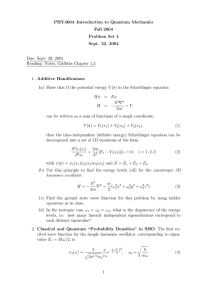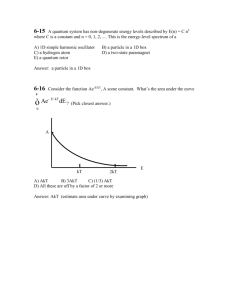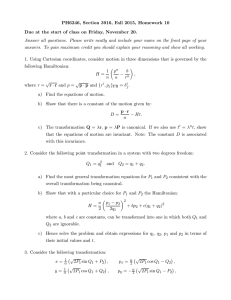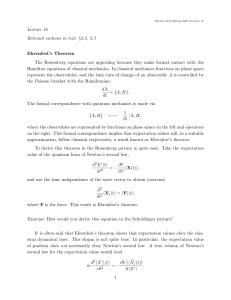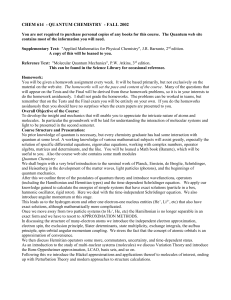Nonlincourse13
advertisement
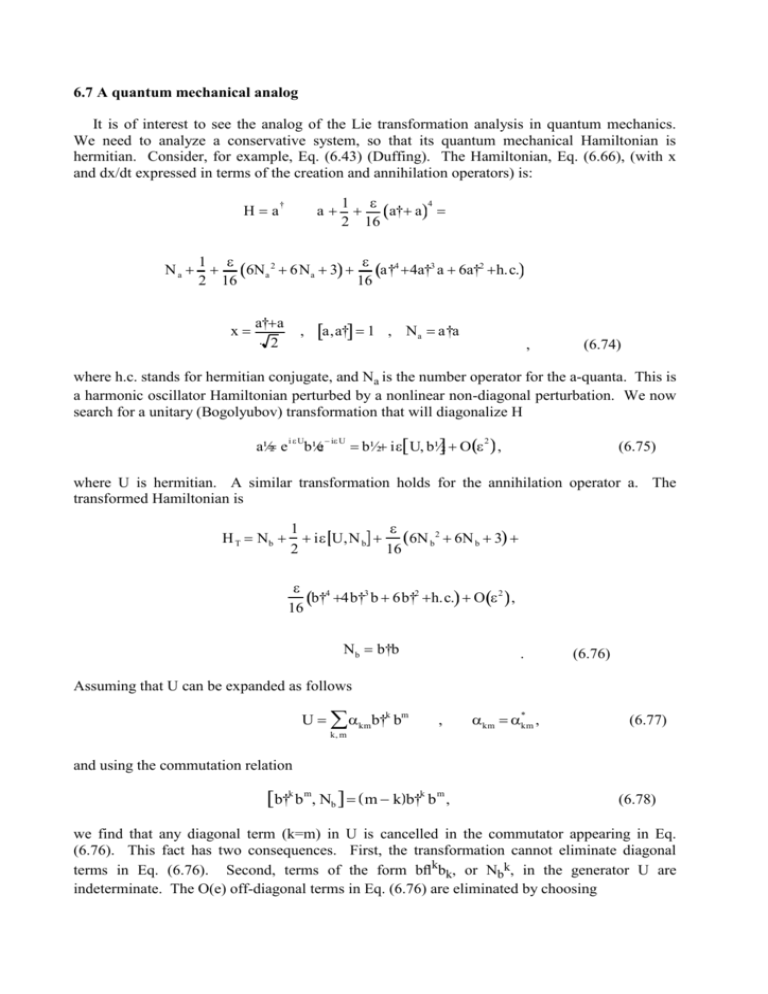
6.7 A quantum mechanical analog It is of interest to see the analog of the Lie transformation analysis in quantum mechanics. We need to analyze a conservative system, so that its quantum mechanical Hamiltonian is hermitian. Consider, for example, Eq. (6.43) (Duffing). The Hamiltonian, Eq. (6.66), (with x and dx/dt expressed in terms of the creation and annihilation operators) is: Ha Na † a 4 1 a† a 2 16 1 6Na 2 6Na 3 a†4 4a†3 a 6a†2 h.c. 2 16 16 x a†a 2 , a,a† 1 , Na a†a , (6.74) where h.c. stands for hermitian conjugate, and Na is the number operator for the a-quanta. This is a harmonic oscillator Hamiltonian perturbed by a nonlinear non-diagonal perturbation. We now search for a unitary (Bogolyubov) transformation that will diagonalize H a½ e i Ub½e i U b½ i[ U, b½] O 2 , (6.75) where U is hermitian. A similar transformation holds for the annihilation operator a. The transformed Hamiltonian is H T Nb 1 i U,N b 6N b 2 6N b 3 2 16 b†4 4b†3 b 6b†2 h.c. O 2 , 16 Nb b†b . (6.76) Assuming that U can be expanded as follows U kmb†k bm , km *km , (6.77) k, m and using the commutation relation [b†k b m, Nb ] m kb†k b m , (6.78) we find that any diagonal term (k=m) in U is cancelled in the commutator appearing in Eq. (6.76). This fact has two consequences. First, the transformation cannot eliminate diagonal terms in Eq. (6.76). Second, terms of the form bflkbk, or Nbk, in the generator U are indeterminate. The O(e) off-diagonal terms in Eq. (6.76) are eliminated by choosing U i 4 i 3 3i b† b† b b†2 h.c. 64 8 16 F(Nb ) , (6.79) where F(Nb) is an arbitrary real function of Nb. This yields 2 H T N b 1 6N b 6N b 3 O 2 2 16 . (6.80) The similarity to the classical case is reassuring. Only off-diagonal ("nonresonant") terms can be eliminated by a nonsingular transformation. The resulting Hamiltonian is diagonal, but nonlinear. The generator of the transformation is determined up to a diagonal ("resonant") term. This procedure can be carried out to higher orders, but the results do not change in nature. The classical limit is obtained by computing the transition energy between two adjacent states, |n> and |n+1>, with very large n: E E n 1 E n 1 6 n 1 O 2 8 . (6.81) This becomes the classical result for the frequency correction, since in a harmonic oscillator N b b†b q ip q ip 2 2 1 2 1 2 1 1 2 1 q p x0 , 2 2 2 2 2 (6.82) where x0 is the amplitude and q and p are the coordinate and momentum, respectively, of the unperturbed "b" oscillator. In order to complete the circle, we now convert the diagonalized Hamiltonian of Eq. (6.80) to its classical analog, using the same transformation as in Eq. (6.82). The result is 1 3 H T, classical 2 q 2 p 2 32 q 2 p 22 1 O 2 . (6.83) Hamilton's equations yield q H p 3 p q 2 p 2 O 2 p 8 H 3 p q q q 2 p 2 O 2 q 8 . (6.84) Defining w=q+i p, Eq. (6.47) for w (through O(e)) is rederived. Thus, of the infinite number of canonical transformations that one may generate in the classical problem, the one that only retains all the resonant terms is the analog of the usual diagonalization procedure in the corresponding quantum mechanical problem. Only tedious algebra is needed in order to show that the findings of this section apply to an harmonic oscillator which is perturbed by a conservative nonlinear term. Finally, the perturbative analysis fails both in the classical limit (when ex02=O(1)) as well as in the quantum case (when en=O(1)).

